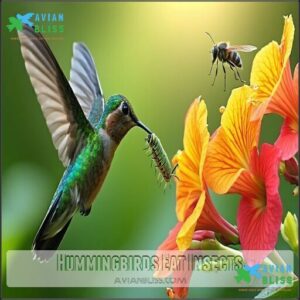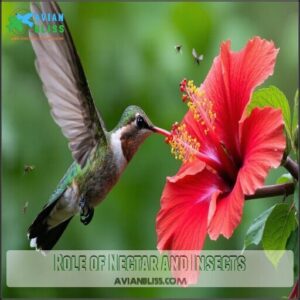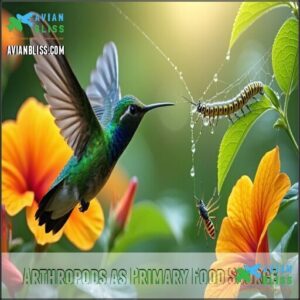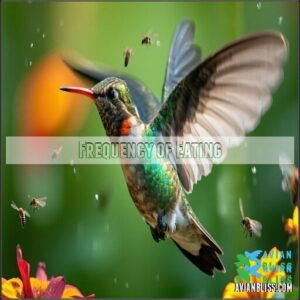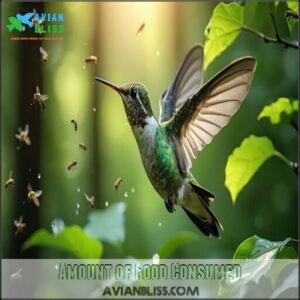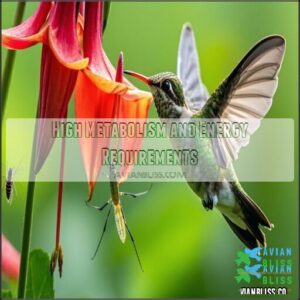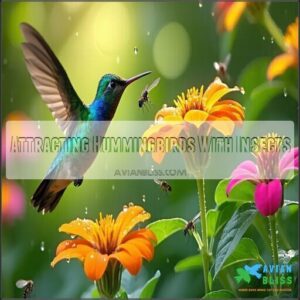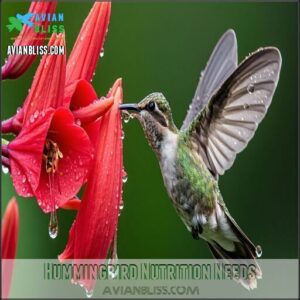This site is supported by our readers. We may earn a commission, at no cost to you, if you purchase through links.
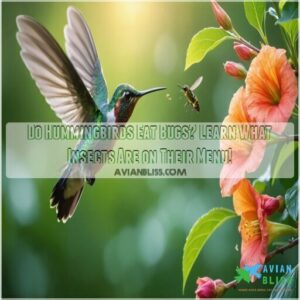
You might catch a hummingbird snapping an insect mid-air or picking one off a leaf with precision that rivals a top chef. Bugs provide essential nutrients, like protein and vitamins, that nectar simply can’t.
It’s all about balance—nectar fuels their zippy energy, while insects build strong feathers and muscles.
Next time you see one darting around, imagine it hunting like a miniature raptor. Curious how you can attract these bug-hunting beauties?
Table Of Contents
- Key Takeaways
- Hummingbirds Eat Insects
- Do Hummingbirds Eat Bugs
- Hummingbird Diet Composition
- Hummingbird Feeding Habits
- Attracting Hummingbirds With Insects
- Hummingbird Nutrition Needs
- Frequently Asked Questions (FAQs)
- Do hummingbirds eat bugs?
- How many insects do hummingbirds eat a day?
- Do hummingbirds rely on insects?
- What do hummingbirds eat?
- Do Baby hummingbirds eat insects?
- Do hummingbirds eat spiders?
- Why put aluminum foil around a hummingbird feeder?
- What is the most common predator of a hummingbird?
- Do hummingbirds keep mosquitoes away?
- What is a hummingbird’s favorite food?
- Conclusion
Key Takeaways
- Hummingbirds don’t just sip nectar—they hunt bugs like flies, gnats, and spiders for the protein and nutrients nectar doesn’t provide.
- Bugs are essential for hummingbirds, making up to 80% of their diet during peak seasons like breeding and migration.
- They’ll snag insects mid-air, pick them off leaves, or raid spiderwebs, showcasing their agility and hunting skills.
- Creating a bug-friendly yard with native plants and avoiding pesticides helps attract these energetic, bug-hunting birds.
Hummingbirds Eat Insects
You might think hummingbirds survive solely on nectar, but they’re expert insect hunters too.
Hummingbirds masterfully hunt insects, proving nectar alone isn’t enough for their high-energy, protein-fueled lifestyles.
From tiny flies to spiders, these agile birds snag bugs midair or pluck them off flowers to get the essential protein and nutrients they need.
Types of Insects Consumed
Hummingbirds adore small, easy-to-swallow insects, like flies, gnats, mosquitoes, and aphids.
Spiders are a preferred prey, often making up most of their diet. They even snack on insect larvae and eggs! Seasonal insects like tiny beetles or parasitic wasps also join the menu.
Hummingbird food sources focus on hunting tiny, soft-bodied creatures perfect for their size. To protect these birds, consider that domestic cats are predators, often hunting near feeders, which can be a significant threat to their well-being, making it essential to ensure their safe environment.
Importance of Insects in Diet
For a balanced hummingbird diet, insects are a key protein source, packed with essential nutrients for energy and growth.
Insects fuel hummingbirds’ high-energy lives, delivering vital protein and nutrients essential for their growth, agility, and nonstop flight.
Bug variety guarantees proper mineral intake, supporting muscles and feathers.
Insects hummingbirds eat, like flies and spiders, are essential for dietary balance, especially during breeding.
Hatchling needs demand extra hummingbird protein from these tiny snacks, proving bugs aren’t just side dishes, and are a key part of their development.
Hunting Techniques for Insects
Mid-air hunting shows off a hummingbird’s agility as it zips through swarms, plucking prey with keen eyesight and precise movements.
Web raiding? It’s like fast food for birds, snagging immobilized insects.
Hovering capture involves darting near leaves or webs, snagging bugs on the go.
These hummingbird hunting techniques reveal their knack for catching insects hummingbirds eat with efficiency and flair!
Do Hummingbirds Eat Bugs
Did you know over 80% of a hummingbird’s diet comes from bugs? These tiny creatures need insects to thrive. Nectar provides quick energy, but insects offer the protein, fats, and minerals that keep their high-speed lives buzzing.
Hummingbirds eat a wide variety of prey, including spiders and flying insects. If you’re wondering about their favorites, here’s a quick list:
- Small spiders: A protein-packed snack with web-raiding benefits.
- Flies and gnats: Perfect for a quick mid-air grab.
- Mosquitoes: Easy pickings and rich in insect nutritional value.
- Aphids: Tiny but essential for a balanced diet.
- Larvae: Packed with nutrients before they become adult bugs.
Curious about pesticide exposure risks? Avoiding treated areas keeps them safe. To protect hummingbirds, consider that cats are major threats.
Hummingbird Diet Composition
Hummingbirds don’t just survive on nectar; they rely on insects for essential nutrients like protein and fats.
Understanding their diet shows you how both nectar and bugs keep these tiny, energetic birds thriving.
Role of Nectar and Insects
In the context of eating, nectar fuels a hummingbird’s energy, but it’s not the whole story.
Insect nutrients provide essential proteins, fats, and vitamins that nectar alone can’t. This dietary balance keeps these tiny birds zipping around with vigor.
Think of nectar as their coffee, while bugs are the full meal. Here’s how both contribute:
| Source | Benefit | Proportion in Diet |
|---|---|---|
| Nectar | Quick energy (sugars) | 20% |
| Insects | Proteins, vitamins | 80% |
| Combined Diet | Sustains activity, health | 100% |
Arthropods as Primary Food Source
Although nectar fuels their energy, arthropods provide essential protein and nutrients for a balanced hummingbird diet.
From swift web raiding to efficient midair hunting, their dietary adaptations are impressive.
Insects, bugs, spiders, and even larvae are essential parts of their menu, making hummingbird insects a primary food source.
These tiny creatures meet protein and fat needs, making them necessary for survival.
Seasonal Variations in Diet
Hummingbird feeding habits shift with the seasons to match food availability. During breeding season, nectar abundance supports high-energy demands.
As nectar fades in colder months, winter insects become essential for protein. Migration diets ramp up with increased insect consumption to fuel the journey.
To help other bird species during this time, consider cold weather feeding strategies.
Here’s how the hummingbird diet adapts:
- Summer: Nectar dominates.
- Winter: Insects thrive.
- Migration: High-protein meals.
- Breeding season: Energy-packed nectar, which is crucial for high-energy demands and supports the hummingbirds’ need for energy-packed food sources.
Hummingbird Feeding Habits
You might think hummingbirds survive only on nectar, but they actually eat bugs to meet their high-energy demands.
With a lightning-fast metabolism, they need frequent meals packed with protein and nutrients to stay fueled.
Frequency of Eating
Hummingbirds are tiny, but their appetites are massive. They eat every 10-15 minutes, hunting insects and sipping nectar to fuel their high-energy lives.
With such fast metabolisms, frequent feeding is non-negotiable. Seasonal eating changes influence their routines, especially post-nesting.
Check out how their daily insect intake stacks up below:
| Feeding Aspect | Time Frequency | Insect Count | Energy Purpose | Key Note |
|---|---|---|---|---|
| Feeding Intervals | 10-15 minutes | 30-50 bugs | Energy boost | Constant food hunting |
| Peak Consumption | Early morning | 100+ insects | Morning energy surge | Essential for activity |
| Daily Insect Intake | Varies seasonally | 300+ bugs | Breeding needs | Increases with demand |
| Post-Nesting | Every few hours | 50 insects | Recovery nutrition | Protein-rich prey |
| Seasonal Eating Changes | Winter/spring | Changes vary | Migration strength | Food scarcity impacts |
The table highlights the variations in feeding patterns, including peak consumption times and the importance of seasonal eating changes. Understanding these patterns is crucial for appreciating the complex needs of hummingbirds and how they adapt to different situations, such as post-nesting recovery and migration.
Amount of Food Consumed
Feeding so frequently leads to surprising numbers. A hummingbird’s daily intake includes consuming up to half its body weight in nectar and hummingbird prey.
That’s hundreds of insects to meet their energy expenditure! Like swallows, hummingbirds also use agile flight techniques to catch insects.
Their dietary proportions look like this:
- 50% nectar volume for quick energy.
- Several hundred insects daily.
- Preferred small bugs like gnats or aphids.
- Constant feeding intervals.
- Nimble aerial hunting for tiny prey.
High Metabolism and Energy Requirements
With one of nature’s fastest metabolic rates, hummingbird energy demands are sky-high.
You’ll be amazed—they feed every 10-15 minutes, consuming caloric intake equivalent to half their body weight daily.
Want to know what hummingbirds eat? Here’s a quick breakdown:
| Factor | Why Important | Impact |
|---|---|---|
| Energy Expenditure | Supports constant flight | Requires frequent feeding |
| Metabolic Rate | 10x a resting human’s | Drives high caloric needs |
| Dietary Adaptations | Insects + nectar combo | Guarantees balanced hummingbird nutrition |
Attracting Hummingbirds With Insects
If you want to attract hummingbirds to your yard, creating a bug-friendly environment is a great start.
By encouraging a natural supply of tiny insects, you’re providing the essential protein they need to thrive.
Creating a Bug-Friendly Environment
To attract hummingbirds, create a bug-friendly environment by planting native plants that support insect growth.
Add water sources like shallow fountains, and scatter overripe fruit attractants to draw tiny bugs.
Avoid pesticides, as they harm both insects and birds.
Offer shelter creation, such as shrubs, for resting spots, and consider using bug-friendly plants to further enhance the hummingbird garden.
A hummingbird garden buzzing with activity guarantees plenty of natural hummingbird food.
Offering Mealworms and Other Insects
Mealworms mightn’t make the cut—hummingbirds prefer smaller insects like gnats or fruit flies.
Skip dried insects; they’re not ideal. Instead, attract bugs with fruit plates or slurries, creating natural feeders.
Live insect sourcing, like attracting flies, offers a steady protein boost. Some enthusiasts even offer mealworms for hummingbirds as a supplement.
Wondering, “Do hummingbirds eat spiders?” Yes, but they’ll hunt on their terms for protein-packed snacks!
Tips for Feeding Hummingbirds Insects
If you want to keep hummingbirds happy, think natural insectaries!
Set out fruit fly cultures or overripe fruit to attract beneficial bugs, and manage spiderwebs—they provide snacks and nest material.
You can also attract insects and hummingbirds with specialized products.
Avoid pesticides, as they harm both insects and birds.
Creating these tiny buffets boosts their protein intake, making your yard a haven for hummingbirds and their bug-hunting adventures.
Hummingbird Nutrition Needs
You might think hummingbirds live solely on nectar, but they actually need a balanced diet to thrive.
Protein, vitamins, and even fats from insects are essential for their energy-intensive lifestyles, especially during migration and breeding.
Importance of Protein and Vitamins
Protein and vitamins keep hummingbirds flying strong, fueling energy production and growth development.
Bugs in their diet deliver these nutrients, supporting immune health.
Hummingbirds aren’t picky but favor these protein-packed snacks:
- Tiny spiders for immune support.
- Gnats loaded with vitamin benefits.
- Aphids aiding energy needs.
- Mosquitoes boosting protein sources.
- Small beetles for overall health.
Protein and vitamins—nature’s unbeatable combo, providing immune health!
Role of Water in Hummingbird Diet
How do hummingbirds stay hydrated?
While nectar provides moisture, water sources like dew and humidity play a essential role.
These tiny birds rely on hydration sources to support their high-energy diet of insects and nectar.
Bathing habits keep feathers clean, while water purity matters for good health.
In a hummingbird’s nutrition, water’s necessity is as critical as finding the perfect flower.
Geographical Differences in Diet
Depending on location, hummingbirds’ diets shift due to habitat impact and seasonal changes.
Regional prey availability, insect abundance, and nectar sources play key roles.
Tropical areas offer diverse bugs like spiders and aphids, while migration influences food access across elevations.
These insectivorous birds adapt diets to survive, proving nature’s tiniest superheroes can still make major adjustments to thrive year-round, as regional prey availability is crucial for their survival.
Frequently Asked Questions (FAQs)
Do hummingbirds eat bugs?
Sure thing, hummingbirds frequently dine on bugs like gnats, mosquitoes, aphids, and spiders.
Bugs provide them with essential nutrients like protein, fiber, and fats—perfect for their insanely active lifestyle.
Think of bugs as their power snacks!
How many insects do hummingbirds eat a day?
Imagine a tiny bird hovering like a dart in the air.
Every day, a hummingbird devours several dozen to over 1,000 insects, depending on energy needs.
It’s nature’s way of fueling such vibrant energy.
Do hummingbirds rely on insects?
They absolutely rely on insects!
These tiny critters are like a protein-packed energy bar, supplying essential nutrients hummingbirds can’t get from nectar alone.
Bugs fuel their high-energy lifestyle and help them thrive, especially during migrations.
What do hummingbirds eat?
Imagine this: hummingbirds are like tiny acrobats fueling up for a show, sipping nectar for carbs and munching insects for proteins, fats, and nutrients.
They thrive on flies, spiders, gnats, and other small bugs.
Do Baby hummingbirds eat insects?
Baby hummingbirds eat insects for essential protein, vitamins, and minerals critical to their growth.
Their parents hunt tiny bugs like spiders, aphids, and gnats, delivering them directly into the hatchlings’ mouths for easy digestion.
Do hummingbirds eat spiders?
Yes, hummingbirds eat spiders.
They swoop in like tiny aerial acrobats, snagging spiders for protein-rich meals.
Spiders also fuel their high-energy lives but additionally provide webbing for nest-building—talk about multitasking at its finest!
Why put aluminum foil around a hummingbird feeder?
Wrapping aluminum foil around a hummingbird feeder keeps ants at bay, reflecting light to confuse them.
Plus, it helps prevent heat buildup in nectar, keeping it fresh longer—a simple trick with big benefits for your feathered visitors, and this is a simple trick.
What is the most common predator of a hummingbird?
The most common predator of a hummingbird is the praying mantis.
Surprisingly, these insects ambush hummingbirds near feeders or flowers, blending in silently to snatch them mid-hover, proving size isn’t everything in the wild!
Do hummingbirds keep mosquitoes away?
Hummingbirds can eat mosquitoes, but they’re not your backyard pest control.
Mosquitoes make up a small part of their diet since hummingbirds prefer more nutritious bugs like gnats, spiders, and aphids to fuel their energetic lives.
What is a hummingbird’s favorite food?
It’s ironic, but nectar isn’t their real favorite—it’s more of a sugary pick-me-up.
They adore insects like spiders, fruit flies, and gnats, which provide the protein, fats, and nutrients they truly need to thrive.
Conclusion
Picture a hummingbird as a tiny, jeweled hunter, balancing nectar’s sweetness with protein-rich insects for survival.
These agile flyers eat bugs like gnats, flies, and spiders to fuel their high-energy lives and maintain strong muscles and feathers.
By knowing that hummingbirds eat bugs, you can create a bug-friendly yard to attract them.
Whether snapping insects mid-air or plucking them from leaves, they’re nature’s tiniest acrobats—adding both beauty and balance to your ecosystem, and helping to maintain a natural balance.
Why not welcome them today?
- https://ucanr.edu/blog/bug-squad/article/what-you-may-not-know-about-hummingbirds
- https://www.allaboutbirds.org/news/not-all-sweetness-and-light-the-real-diet-of-hummingbirds/
- https://bwdmagazine.com/backyard-birding-time/hummingbirds/what-do-hummingbirds-eat/
- https://blogs.k-state.edu/kansasbugs/2021/10/21/do-hummingbirds-feed-on-insects/
- https://askabiologist.asu.edu/hummingbird-foraging

